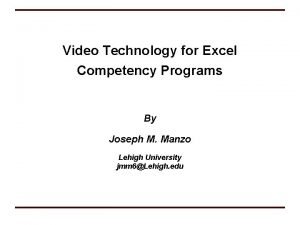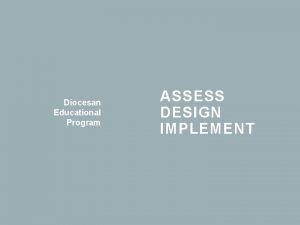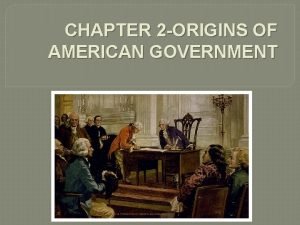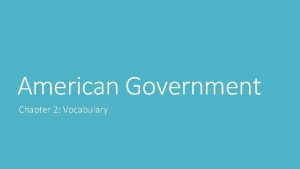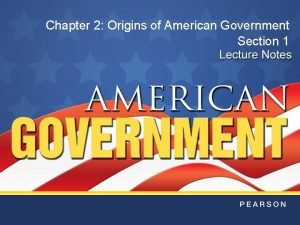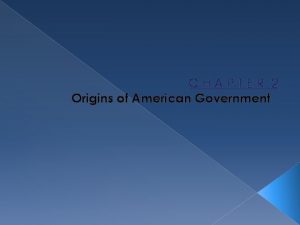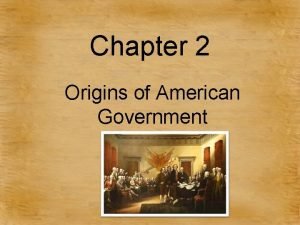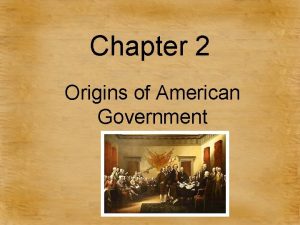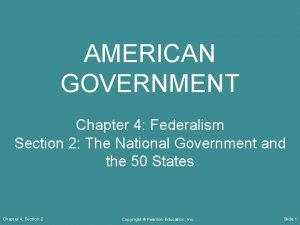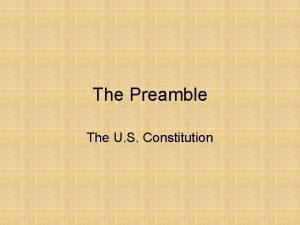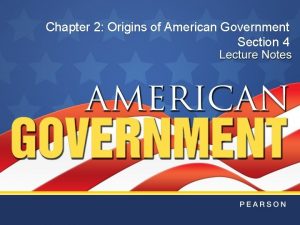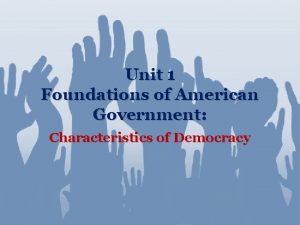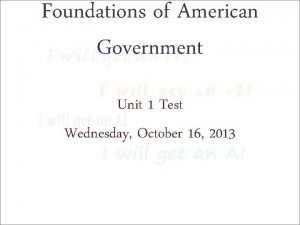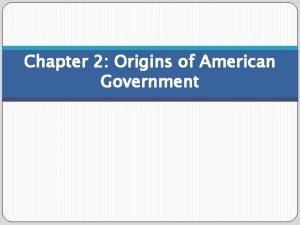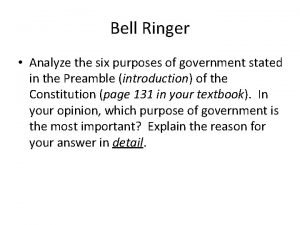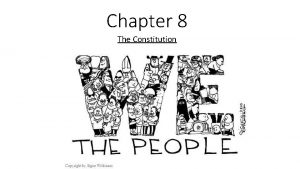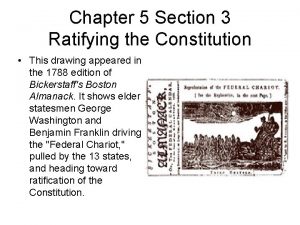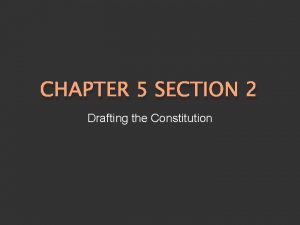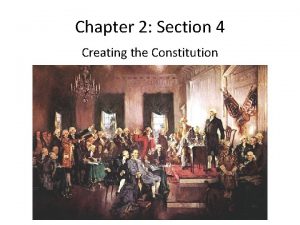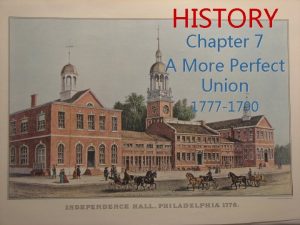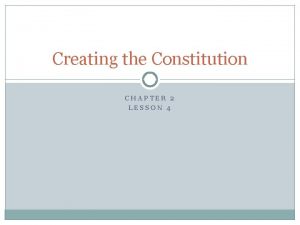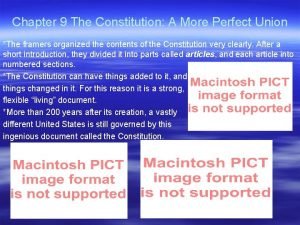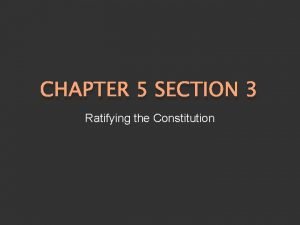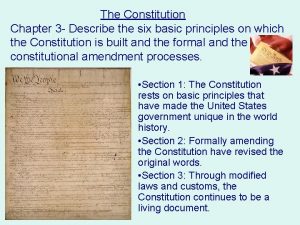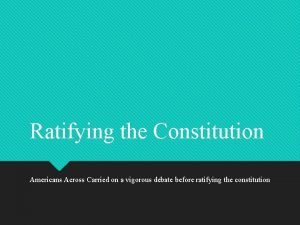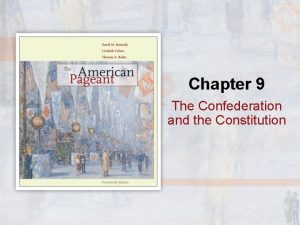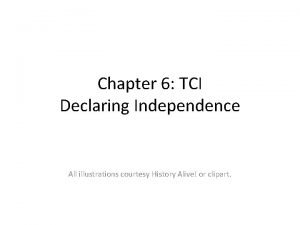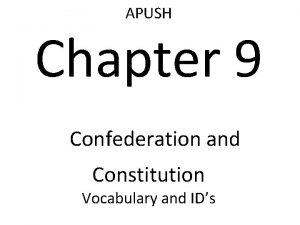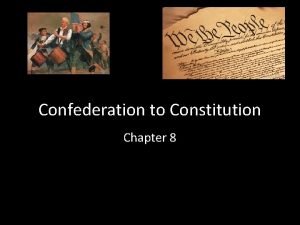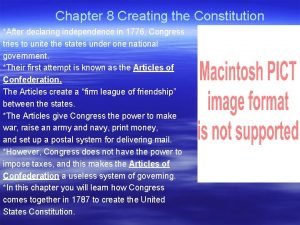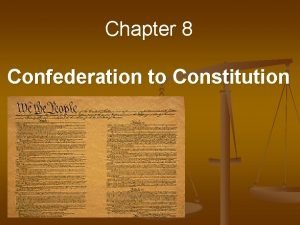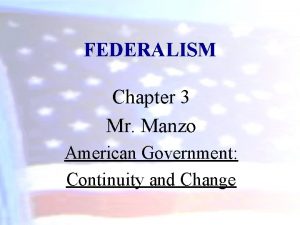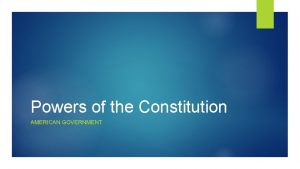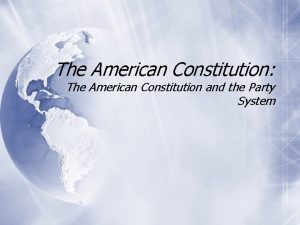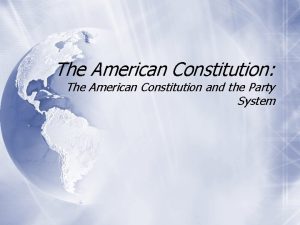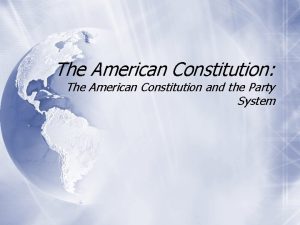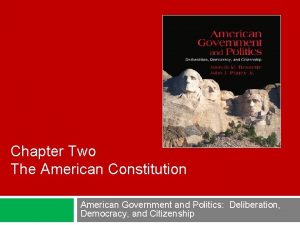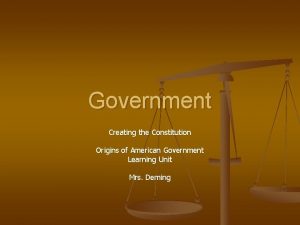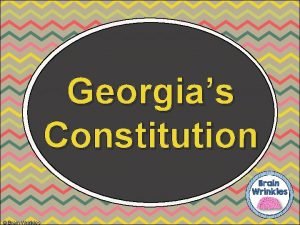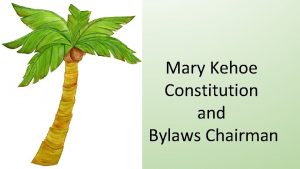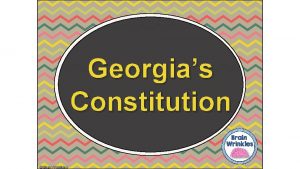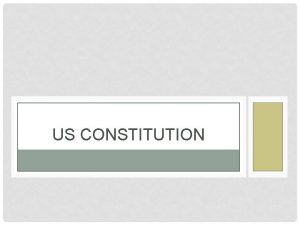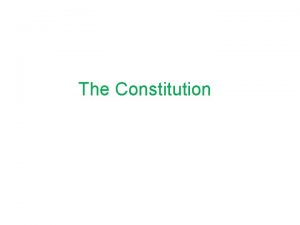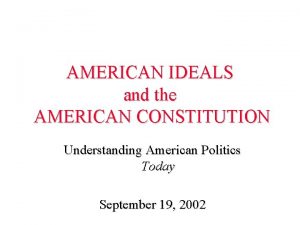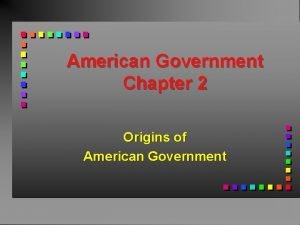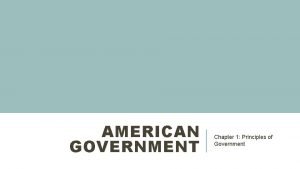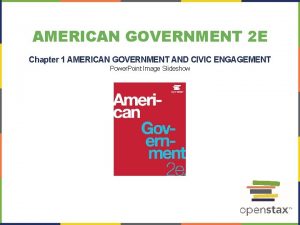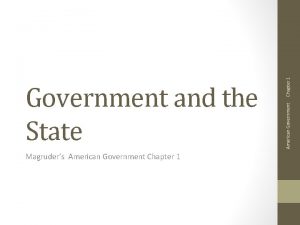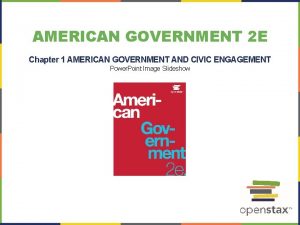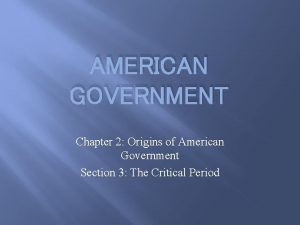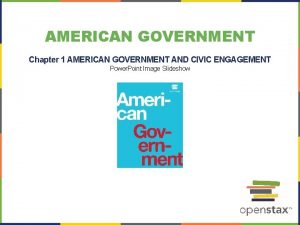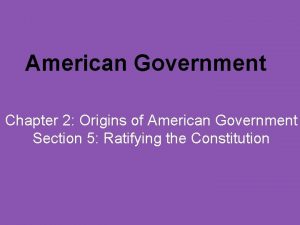The Constitution Chapter 2 Mr Manzo American Government











































- Slides: 43

The Constitution Chapter 2 Mr. Manzo American Government: Continuity and Change

The Constitution In this chapter we will cover… 1. The Origins of a New Nation 2. The Declaration of Independence 3. The Articles of Confederation 4. Writing the Constitution 5. The Basic Principles of the U. S. Constitution 6. Methods of Amending the Constitution

The Origins of a New Nation • Colonists came to the New World during the 1600 s for a variety of reasons including – to escape religious persecution – find plentiful land – and to seek a new start in life. • The colonists were allowed significant liberties in terms of self-government, religious practices, and economic organization.

Trade and Taxation • The British followed a national policy of mercantilism. • The colonists were outraged. Violent protests began. • The Sons of Liberty were organized by Samuel Adams and Patrick Henry to act out against the Crown.

The First Continental Congress • The Continental Congress met in Philadelphia in September and October 1774. • They were not yet thinking of open rebellion. • They called for colonial rights of petition and assembly, trial by peers, freedom from a standing army, and the selection of representative councils to levy taxes.

The Second Continental Congress • King George refused the demands of the Continental Congress. • Thus the Second Continental Congress convened on May 10, 1775, and were united in their hostility toward Britain. • King George sent 20, 000 more troops and the Revolutionary War had begun.

The Declaration of Independence • On July 2, 1776 the colonies voted for independence (except New York which abstained). • On July 4, 1776 the Congress adopted the Declaration of Independence penned by Thomas Jefferson. • The philosophies that shaped the Declaration of Independence form theoretical basis for the new government.

The Articles of Confederation • The colonists wanted a constitution--a written document that defines rights and obligations and puts limits on government. Debates on Representation, Taxation/Slavery, Western lands (MA, NY, V, CT, NC) vs. (MD, NJ, NH, DE) • Win at Saratoga, convince foreign powers to ally with the American cause. • The colonists created a loose league of friendship under "The Articles of Confederation. “ 1781 put into effect. • The Articles were created predominantly as reaction to the unitary system used in Britain in which all of the power and sovereignty is vested in the central government. • Edward Rutledge – South Carolina, suspicious of regional prejudices, New England as a central power.

Problems of the Articles of Confederation • The government created under the Articles saw the new country through the Revolutionary War. [consider presentism] • However, once the British surrendered in 1781, the country was no longer united by a common enemy or purpose. • Foreign Policy – Great Britain refused to cooperate w/ Treaty of Paris. [Abandon Posts & Forts in Western lands], French & Spanish – control over the Mississippi, trade, & shipping. What can the Confederation Congress do? • Under the Articles the Congress had trouble getting a quorum of nine states to conduct business. Even when quorum was made, the states did nothing but bicker. [ Rufus King of NY – Pennsylvania & Connecticut] • States are concerned with their own issues.

Problems of the Articles of Confederation • Independent Republic of Vermont – Issue of succession & independence issues w/ NY & NH. Annexed towns in NH, border skirmishes in NY. • Negotiating w/ Great Britain during the war, what can Congress do? • End of war came, Vermont remained in limbo. • State of Franklin in North Carolina dispute over western lands given over to Congress. Write a constitution. NC gave up its idea to give land. • Boundary dispute between NY & Pennsylvania. Congress no power to enforce. • Congress not able to enforce decisions.

Problems Under the Articles of Confederation • The Congress had no power to tax. States coined their own money and trade wars erupted. • Congress had no power to regulate commerce among the states or ensure a unified monetary system. • States conducted foreign relations without regard to neighboring states' needs or wants. Duties, tariffs, and taxes on trade proliferated with different ones in each state.

Failure of the Articles • The economy began to deteriorate. Several years of bad harvests ensued. Farmers went into ever-deeper debt. • Many leaders worried about questions of defense, trade, and frontier expansion. • Under the Articles, the central government was not strong enough to cope with these problems. • By 1786, several states had called for a convention to discuss ways of strengthening the national government.

Daniel Shays 1747 -1825 Lieutenant Shays. He fought at Bunker Hill and at Ticonderoga. By 1777, Shays had leveraged his ability to raise men willing to serve under him into a Captain's commission in the Fifth Massachusetts Regiment of the Continental Army. Captain Shays continued to build his reputation as a courageous and competent officer, including fighting Burgoyne's invading army at Saratoga, New York, and participating in the desperate action at Stony Point, New York. General Lafayette himself honored Captain Shays along with other officers under his command with a ceremonial sword as a mark of his personal esteem.

Daniel Shays’ Rebellion • Before that convention could meet, unrest broke out in America. In Massachusetts, banks were foreclosing on farms and the Massachusetts legislature enacted a new law requiring all debts be paid in cash. • Daniel Shays, a Revolutionary War veteran, was outraged and frustrated with the new law and the huge debt burden of farmers. • Shays led a group of 1, 100 armed and disgruntled farmers to the capital, Springfield. They forcibly prevented the state court from foreclosing on their farms.

Factors leading to Shays rebellion Eastern Massachusetts • • Highly developed Economy Monetary based Wealthy Cities International merchants, plantation and slave owners. • Money lenders, bankers.

Factors leading to Shays rebellion Western Massachusetts • • Underdeveloped economy Barter system Poorer cities Freed slaves, small merchants, laborers, servants. • Money borrors

Daniel Shays filed this request for a Continental Army pension in 1818. Good example of Protest.

Daniel Shays' home in Pelham. Massachusetts General Court

Daniel Shays Conkey's Tavern in Pelham was a popular gathering place for Daniel Shays and other local Regulators.

Shays’s Rebellion • Congress authorized the Secretary of War to call up a national militia to respond appropriated $530, 000 for the purpose. Every state refused, except Virginia. • Finally, a private army (wealthy lawyers, merchants in Massachusetts) put down Shay's Rebellion. • This failure of Congress to protect the citizens and property of Americans was a glaring example of the problems of the Articles. • Shay’s fled and went to the Independent Republic of Vermont. • Newberg, NY Conspiracy – pensions not received army remains, George Washington. • Mini revolt in Pennsylvania – no pay for soldiers. Members of Congress threatened. • Major distrust of Standing Armies.

Writing the Constitution • Nationalists preserving the revolution. • On February 21, 1787, Congress called for a Constitutional Convention in Philadelphia "for the sole and express purpose of revising the Articles of Confederation. “ • Debates in States to attend Constitutional Convention. CT delegates “Endanger the rights of Americans” Fears. • CT Delegates – powerlessness of Congress, stronger central government, union invaded? • RI does not attend. 12 states represented at Federal “Constitutional” Convention. 55 delegates attend, well educated, lawyers, worked in state governments. People involved in public life. • Washington (presides), Franklin (International reputation), Madison (notes, & creation of a plan of government – Virginia Plan. Sets the terms of debate. (agenda & debate = win) • May 29, 1787, the convention met and the Virginia delegation suggested they throw out the Articles and devise a new system of government! • This act could be considered treason, so they adopted a pledge of secrecy so the people their could really speak their minds. Open & free debate. • William Pierce story.

Tribe and Dorf How Not to Read the Constitution • Interpreting the constitution necessarily involves “looking beyond the specific views of the Framers. ” • Constitution is a framework for “balancing liberty against power. ” • Adapting the Constitution’s framework to our changing needs and values is difficult and complex

Roche, Founding Fathers • 1. The founding fathers were not, in fact, radical revolutionaries. They were democrats, superb democratic politicians. Political men committed to working within a democratic framework, within universal public approval. The National reform caucus had one goal –popular approbation (approval)

Roche, Founding Fathers • 2. They could succeed only if the people of the U. S. endorsed the constitution by regularized procedures. They had to change the Articles by working within the prevailing rules of the game.

Roche, Founding Fathers • 3. Framers were plotting to establish a stronger central government than existed under the Articles. • 4. Their greatest achievement of the Constitutionalists was their success in convincing the elected representatives of a majority of white males that change was imperative.

Roche, Founding Fathers • 5. According to Roche, there was a clear-cut ideological division at the Convention, There were structural rather than ideological differences. • 6. Roche claims that states’ righters had not accepted the fundamental purposes of the Convention, they could have simply pulled out and by doing so have aborted the whole enterprise.

Roche, Founding Fathers • 7. The Virginia plan envisioned a unitary national government freed from and dominant over the states. Bicameral Government -Lower house of the national legislature was to be elected directly by the people with membership proportional to population. Upper house selected by the lower house named by candidates selected by the lower house. Executive – w/ veto power over acts of Congress, Judiciary of one or more supreme judges selected by Congress. Holding office during good behavior. Flexible Amendment process, and a procedure for admitting new states. Basic outline of the Constitution. • New National Government

Roche, Founding Fathers • 8. Small states realized that under the Virginia Plan, Massachusetts, Virginia, and Pennsylvania could virtually dominate the national government – and they probably appreciated that to sell the program to the folks back home would be impossible.

Roche, Founding Fathers • 9. Roche claims that a careful examination of evidence indicates that the New Jersey Plan (1 House Legislature, plural executive elected by Congress, Supreme Court elected by executive) appeared at the Convention as a recognition of political reality rather than an affirmation of states’ rights. The advocates of the NJ Plan intended to substitute for the Virginia Plan a system that would both retain a strong national power and have a chance of adoption in the states. William Patterson, said, “ I came here not to speak of my own sentiments, but rather the sentiments of those who sent me. ” This claims Roche is evidence of political compromise rather than Ideological steadfastness. • Hamilton Plan (6 hour speech) – Centralized and National. Reduced states to administrative subdivisions, each w/ supreme executive appointed by National Government, Chief Executive w/ life term w/ good behavior chosen by electors who are elected by electors popularly chosen. Senate chosen for life. Executive w/ veto power. Praises British Government as the finest on earth. [Praised by all, supported by none, eternal proof he was a Monarchist] Why? Strategic move to push NJ plan out. Hamilton wanted to state his ideas. • Main Issues of the Convention. 1 -Represenatation – Great/Connecticut Compromise July 16, 1787 2 -Slavery – linked to representation. Moment of debate. Article I Section 9. 3 -National Executive – links to the revolution.

Compromises • Great/ Connecticut Compromise • Electoral College: a “jerry-rigged improvisation” that gave a bonus to the small states and settled an argument over the selection of the executive. • - Three-Fifths Compromise: was a bargain between the Northern & Southern states - compromise of 3/5 representation for slaves for the South • Trade Compromises: The South is allowed to continue slave trade for 20 years & a 20 year ban on cotton taxation in exchange for majority vote for any navigation acts that the Northern states wanted. Article I Section 9 – (1808) • Motivation: Compromises to get passage of the Constitution

Beard, Framing the Constitution • Main argument -The Framers were an economic elite out to protect their own property against popular majorities. • They were distrustful of the majority rule and sought to structure the government to prevent democratic excess and protect the interests of the propertied class. • Objected to direct popular government – thought the representative form would check the “democratic excesses” of the people and the aristocratic body (Senate) of men of property would hold down the turbulence of democracy • Reasoning -The Framers were an elite consisting of landholders, creditors, merchants, lawyers, and public bondholders. • Significance – Constitution is anti-majoritarian • Roche and Beard disagree on the motives and actions of the Framers.

Beard’s Evidence o Many of the delegates were the economic elite o Senate elites chosen via State legislatures. o Checks & balances were built in the doctrine that one popular branch of government cannot be allowed to sway or enact laws touching on property o There was exclusion of direct vote for President and Senate o There was an independent judiciary

Anti Federalists Opposed Constitution • The Anti-Federalists opposed ratification of the Constitution • A desire to establish a weak central government (Articles) • A corresponding desire for strong state governments • support of many small farmers and small landowners • The support of debtor elements who felt that strong state legislatures were more sympathetic to them than a strong central government.

Federalists In Favor of Constitution • A desire to establish a strong central government • A corresponding desire for weaker state governments • The support of many large landowners, judges, lawyers, leading clergymen and merchants • The support of creditor elements who felt that a strong central government would give protection to public and private credit.


The Virginia and New Jersey Plans • The delegates submitted plans for a new government. • The Virginia Plan proposed that sovereignty be vested in the people and not the states. • The New Jersey Plan would have primarily strengthened the Articles by giving Congress the ability to raise revenues and would have kept a unicameral legislature chosen by state legislatures.

The Great Compromise • Connecticut offered a compromise taking elements of each plan. • The legislature would be bicameral with the lower house (House of Representatives)based on population and the upper house (Senate) premised on equal representation for the states. • Both houses had to pass all legislation so both small and large states were satisfied.

The Basic Principles of the U. S. Constitution • Federalism - power is divided among the states and the national government. • Separation of Powers – power was divided vertically through federalism and horizontally through separation of powers among the three branches of government. • Checks and Balances - The power of each branch of government is checked or limited and balanced by powers held by other branches.


The Basic Principles of the U. S. Constitution The Supremacy Clause - Article IV says that federal law is supreme. So if the states and federal government argue, the feds win.

The Articles of the Constitution • Article I - establishes the legislative branch. • Article II - establishes the executive branch headed by the president. • Article III - establishes the judicial branch. • Articles IV – establishes the "full faith and credit clause" that mandates that states honor the laws and proceedings of another state. • Articles IV through VII - also include rules on the admission of new states to the union, how amendments can be added to the Constitution, prohibits religious tests for holding office, and set out procedures for the ratification of the document.

Methods of Amending the U. S. Constitution • Formal Method – Article V creates a two-stage process for amending the Constitution: proposal and ratification. • An amendment can be proposed by two-thirds of both houses of Congress or • by two-thirds of state legislatures requesting Congress to call a national convention to propose amendments. • An amendment can be ratified by a favorable vote in three-fourths of all state legislatures or by such a vote in specially called ratifying conventions called in three-fourths of the states. • Informal Method – The Constitution also changes informally through judicial interpretation and through cultural and social change.

 Joseph manzo lehigh
Joseph manzo lehigh Dr laura manzo
Dr laura manzo Texas constitution vs us constitution
Texas constitution vs us constitution Nc constitution vs us constitution
Nc constitution vs us constitution Constitution what is constitution
Constitution what is constitution The constitution lesson 1 principles of the constitution
The constitution lesson 1 principles of the constitution Limited government in the constitution
Limited government in the constitution Flocabulary checks and balances
Flocabulary checks and balances Chapter 2 american government
Chapter 2 american government Origins of american government vocabulary
Origins of american government vocabulary Chapter 2 origins of american government answer key
Chapter 2 origins of american government answer key Chapter 2: origins of american government worksheet answers
Chapter 2: origins of american government worksheet answers Chapter 2 lesson 1 government in colonial america
Chapter 2 lesson 1 government in colonial america Chapter 2 origins of american government
Chapter 2 origins of american government American government chapter 4
American government chapter 4 Preamble to the united states constitution
Preamble to the united states constitution American constitution
American constitution What are the three levels of government
What are the three levels of government Origins of american government section 4
Origins of american government section 4 Ap government unit 1 study guide
Ap government unit 1 study guide Unit 1 foundations of american government
Unit 1 foundations of american government Origins of american government section 1
Origins of american government section 1 Foundations of american government unit 1 test review
Foundations of american government unit 1 test review Origins of american government section 1
Origins of american government section 1 What are six purposes of the american system of government
What are six purposes of the american system of government Chapter 8 lesson 1 principles of the constitution
Chapter 8 lesson 1 principles of the constitution Ratifying the constitution chapter 5 section 3
Ratifying the constitution chapter 5 section 3 Chapter 5 section 2 drafting the constitution
Chapter 5 section 2 drafting the constitution Constitutional convention definition
Constitutional convention definition Chapter 7 lesson 2 forging a new constitution
Chapter 7 lesson 2 forging a new constitution Chapter 2 lesson 4 creating the constitution
Chapter 2 lesson 4 creating the constitution Chapter 9 the constitution a more perfect union
Chapter 9 the constitution a more perfect union Ratifying the constitution chapter 5 section 3
Ratifying the constitution chapter 5 section 3 Chapter 3 section 1 constitution scavenger hunt answers
Chapter 3 section 1 constitution scavenger hunt answers Chapter 5 section 3 ratifying the constitution answer key
Chapter 5 section 3 ratifying the constitution answer key Chapter 9 the confederation and the constitution
Chapter 9 the confederation and the constitution Tci declaration of independence
Tci declaration of independence Chapter 9 confederation and constitution
Chapter 9 confederation and constitution Chapter 8 confederation to constitution
Chapter 8 confederation to constitution Chapter 8 creating the constitution
Chapter 8 creating the constitution Chapter 8 confederation to constitution
Chapter 8 confederation to constitution Hình ảnh bộ gõ cơ thể búng tay
Hình ảnh bộ gõ cơ thể búng tay Bổ thể
Bổ thể
